Start date 1991 | ||
 | ||
Similar Battle of Mogadishu, Ogaden War, Battle for Central Somalia, Ethiopian civil war, Puntland–Somaliland dispute | ||
The Somali Civil War (Somali: Dagaal Sokeeye Soomal, Arabic: الحرب الأهلية الصومالية) is an ongoing civil war taking place in Somalia. It grew out of resistance to the Siad Barre regime during the 1980s. By 1988–90, the Somali Armed Forces began engaging various armed rebel groups, including the Somali Salvation Democratic Front in the northeast, the Somali National Movement in the northwest, and the United Somali Congress in the south. The clan-based armed opposition groups eventually managed to overthrow the Barre government in 1991.
Contents
- Fall of Barre regime 198691
- United Somali Congress topples Barre
- United Nations intervention 199295
- USCSSA 19952000
- TFG Islamic Courts Union and Ethiopia 200609
- Coalition government 2009
- From 2009 onwards
- Casualties
- References
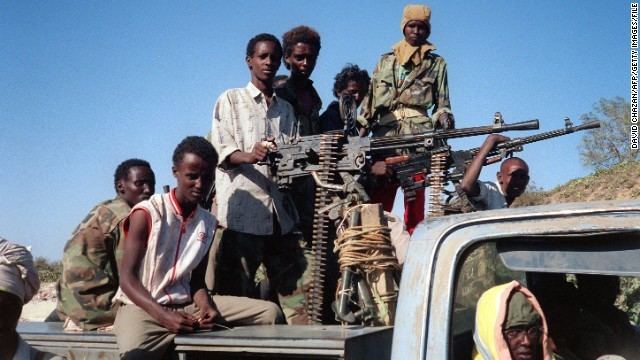
Various armed factions began competing for influence in the power vacuum and turmoil that followed, particularly in the south. In 1990–92 customary law temporarily collapsed due to the fighting. This precipitated the arrival of UNOSOM I UN military observers in July 1992, followed by larger peacekeeping forces. Factional fighting continued in the south. In the absence of a central government, Somalia became a "failed state". The UN withdrew in 1995, having incurred significant casualties, but no central authority had yet been reestablished. After the collapse of the central government, there was some return to customary and religious law in most regions. In 1991 and 1998, two autonomous regional governments were also established in the northern part of the country. This led to a relative decrease in the intensity of the fighting, with SIPRI removing Somalia from its list of major armed conflicts for the years 1997 and 1998.
In 2000, the Transitional National Government was established, followed by the Transitional Federal Government (TFG) in 2004. The trend towards reduced conflict halted in 2005, and sustained and destructive conflict took place in the south in 2005–07. However, the fighting was of a much lower scale and intensity than in the early 1990s. In 2006, Ethiopian troops seized most of the south from the newly formed Islamic Courts Union (ICU). The ICU then splintered into more radical groups, notably Al-Shabaab, which have since been fighting the Somali government and the AU-mandated AMISOM peacekeeping force for control of the country. Somalia topped the annual Fragile States Index for six years between 2008 and 2013.
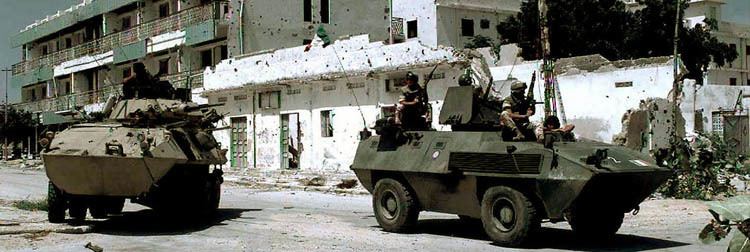
In October 2011, following preparatory meetings, Kenyan troops entered southern Somalia ("Operation Linda Nchi") to fight Al-Shabaab, and to establish a buffer zone inside Somalia. Kenyan troops were formally integrated into the multinational force in February 2012. The Federal Government of Somalia was later established in August 2012, constituting the first permanent central government in the country since the start of the civil war. International stakeholders and analysts have subsequently begun to describe Somalia as a "fragile state", which is making some progress towards stability.
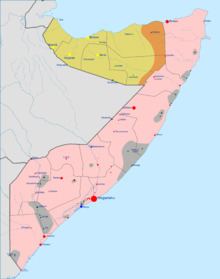
Fall of Barre regime (1986–91)
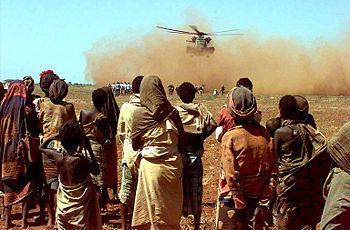
In May 1986, Barre suffered serious injuries in an automobile accident near Mogadishu, when the car that was transporting him smashed into the back of a bus during a heavy rainstorm. He was treated in a hospital in Saudi Arabia for head injuries, broken ribs and shock over a period of a month. Lieutenant General Mohamed Ali Samatar, then Vice President, subsequently served as de facto head of state for the next several months. Although Barre managed to recover enough to present himself as the sole presidential candidate for re-election over a term of seven years on December 23, 1986, his poor health and advanced age led to speculation about who would succeed him in power. Possible contenders included his son-in-law General Ahmed Suleiman Abdille, who was at the time the Minister of the Interior, in addition to Samatar.
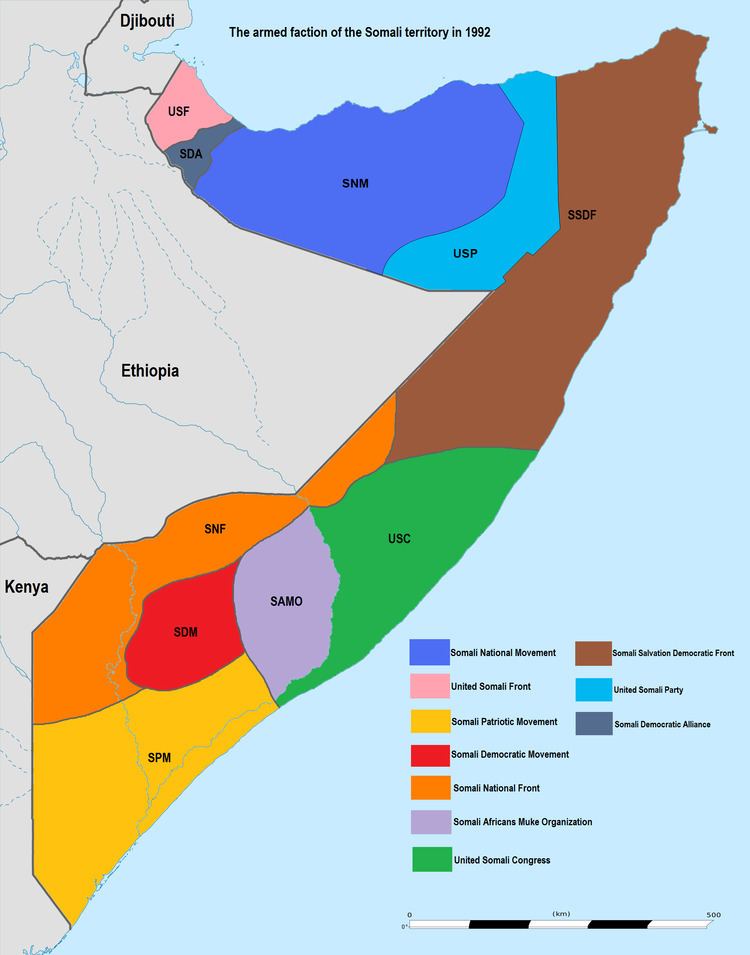
In an effort to hold on to power, Barre's ruling Supreme Revolutionary Council (SRC) became increasingly authoritarian and arbitrary. This caused opposition to his regime to grow. Barre in turn tried to quell the unrest by abandoning appeals to nationalism, relying more and more on his own inner circle, and exploiting historical clan animosities. By the mid-1980s, more resistance movements supported by Ethiopia's communist Derg administration had sprung up across the country. Barre responded by ordering punitive measures against those he perceived as locally supporting the guerrillas, especially in the northern regions. The clampdown included bombing of cities, with the northwestern administrative center of Hargeisa, a Somali National Movement (SNM) stronghold, among the targeted areas in 1988.
In 1990, as fighting intensified, Somalia's first President Aden Abdullah Osman Daar and about 100 other Somali politicians signed a manifesto advocating reconciliation. A number of the signatories were subsequently arrested. Barre's heavy-handed tactics further strengthened the appeal of the various rebel movements, although these groups' only common goal was the overthrow of his regime.
United Somali Congress topples Barre
By mid 1990, United Somali Congress (USC) rebels had captured most towns and villages surrounding Mogadishu, which prompted some to give Barre the ironic title 'Mayor of Mogadishu.' In December the USC entered Mogadishu. Four weeks of battle between Barre's remaining troops and the USC ensued, over the course of which the USC brought more forces into the city. By January 1991, USC rebels had managed to defeat the Red Berets, in the process toppling Barre's regime. The remainder of the regime's forces then finally collapsed. Some became irregular regional forces and clan militias. After the USC's victory over Barre's troops, the other rebel groups declined to cooperate with it, as each instead drew primary support from their own constituencies. Among these other opposition movements were the Somali Patriotic Movement (SPM) and Somali Democratic Alliance (SDA), a Gadabuursi group which had been formed in the northwest to counter the Somali National Movement Isaaq militia. For its part, the SNM initially refused to accept the legitimacy of the provisional government that the USC had established. However, the SNM's former leader Ahmed Mohamed Silanyo later proposed a power-sharing framework in March 1991 between the SNM and USC under a new transitional government.
Many of the opposition groups subsequently began competing for influence in the power vacuum that followed the ouster of Barre's regime. In the south, armed factions led by USC commanders General Mohamed Farah Aidid and Ali Mahdi Mohamed, in particular, clashed as each sought to exert authority over the capital. In the northwest, at the Burao conference of April–May 1991, SNM secessionists proclaimed independence for the region under the name Somaliland. They concurrently selected the SNM's leader Abdirahman Ahmed Ali Tuur as president.
In 1992, after four months of heavy fighting for control of Mogadishu, a ceasefire was agreed between Ali Mahdi Mohamed and Mohamed Farah Aideed. Neither leader had seized control of the capital, and as a result, a 'greenline' was established between north and south that divided their areas of control.
United Nations intervention (1992–95)
UN Security Council Resolution 733 and UN Security Council Resolution 746 led to the creation of the United Nations Operation in Somalia I (UNOSOM I), to provide humanitarian relief and help restore order in Somalia after the dissolution of its central government.
United Nations Security Council Resolution 794 was unanimously passed on December 3, 1992, which approved a coalition of United Nations peacekeepers led by the United States. Forming the Unified Task Force (UNITAF), the alliance was tasked with assuring security until humanitarian efforts aimed at stabilizing the situation were transferred to the UN. Landing in 1993, the UN peacekeeping coalition started the two-year United Nations Operation in Somalia II (UNOSOM II) primarily in the south. UNITAF's original mandate was to use "all necessary means" to guarantee the delivery of humanitarian aid in accordance to Chapter VII of the United Nations Charter.
During negotiations from 1993 to 1995, Somali principals had some success in reconciliation and establishment of public authorities. Among these initiatives was the Mudug peace agreement of June 1993 between Aidid's forces and the SSDF, which established a ceasefire between the Haber Gedir and the Majeerteen clans, opened the trade routes, and formalized the withdrawal of militants from Galkayo; the UNOSOM-mediated Hirab reconciliation of January 1994 in Mogadishu between elders of the rival Abgal and Haber Gedir clans, which was backed by politicians from these constituencies and concluded with a pact to end hostilities, dismantle the green line partitioning the city, and remove road blocks; the UNOSOM-mediated Kismayo initiative of 1994 between the SNA, SPM, SSDF, and representatives of nineteen clans from the southern Lower Juba and Middle Juba regions; the 1994 Bardhere conference between the Marehan and Rahanweyn (Digil and Mirifle), which resolved conflicts over local resources; and the short-lived Digil-Mirifle Governing Council for the southern Bay and Bakool regions, which was established in March 1995.
Some of the militias that were then competing for power saw UNOSOM's presence as a threat to their hegemony. Consequently, gun battles took place in Mogadishu between local gunmen and peacekeepers. Among these was the Battle of Mogadishu in October 1993, an unsuccessful attempt by U.S. troops to apprehend faction leader Aidid. UN soldiers eventually withdrew altogether from the country on March 3, 1995, having incurred more significant casualties.
USC/SSA (1995–2000)
According to Interpeace, after UNOSOM's departure in March 1995, military clashes between local factions became shorter, generally less intense, and more localized. This was in part due to the large-scale UN military intervention that had helped to curb the intense fighting between the major factions, who then began to focus on consolidating gains that they had made. The local peace and reconciliation initiatives that had been undertaken in the south-central part of the country between 1993 and 1995 also generally had a positive impact.
Aidid subsequently declared himself President of Somalia on June 15, 1995. However, his declaration received no recognition, as his rival Ali Mahdi Muhammad had already been elected interim President at a conference in Djibouti and recognized as such by the international community.
Consequently, Aidid's faction continued its quest for hegemony in the south. In September 1995, militia forces loyal to him attacked and occupied the city of Baidoa. Aidid's forces remained in control of Baidoa from September 1995 to at least January 1996, while the local Rahanweyn Resistance Army militia continued to engage his forces in the town's environs.
Fighting continued in the later half of 1995 in southern Kismayo and the Juba Valley, as well as southwestern and central Somalia. However, despite these pockets of conflict, the Gedo and Middle Shabelle regions, in addition to both the northeastern and northwestern parts of the country remained relatively peaceful. A number of the regional and district administrations that had been locally established in the preceding few years continued to operate in these areas.
In March 1996, Ali Mahdi was elected chairman of the United Somali Congress/Somali Salvation Alliance (USC/SSA), based in northern Mogadishu. In the southern part of city, Aidid's forces battled those of Osman Atto for control of the port of Merca as well as strategic areas in Mogadishu. Fighting in Merca eventually ended after elders intervened, but continued in Mogadishu. In August 1996, Aidid died from wounds incurred during combat in the Medina area.
In 1998, a homegrown constitutional conference was held in the northeastern town of Garowe over a period of three months. Attended by the area's political elite, traditional elders (Issims), members of the business community, intellectuals and other civil society representatives, the autonomous Puntland State of Somalia was subsequently officially established so as to deliver services to the population, offer security, facilitate trade, and interact with both domestic and international partners.
In 1999, Eritrea was alleged to be supporting Somali National Alliance forces led by the late Aidid's son Hussein Farrah Aidid. Aidid jr. denied the claims, saying that the Ethiopian Prime Minister Meles Zenawi had requested that he mediate between Ethiopia and Eritrea in their separate conflict. However the International Institute for Strategic Studies separately reported that Hussein Aideed himself had acknowledged support from both Eritrea and Uganda. Aideed's forces occupied Baidoa in May 1999. However they were driven out by the Rahanweyn Resistance Army in June 1999, backed by an Ethiopian force of up to 3,000 using tanks and artillery. The IISS said that the attack was part of a strategy to prevent Eritrea opening up a new front. By the end of the year, the Rahanweyn Resistance Army had taken control of the southern Bay and Bakool provinces. The RRA's leader Hasan Muhammad Nur Shatigadud subsequently established the Southwestern State of Somalia regional administration.
In 2000, Ali Mahdi participated in another conference in Djibouti. He lost a re-election bid there to Barre's former Interior Minister Abdiqasim Salad Hassan.
TFG, Islamic Courts Union, and Ethiopia (2006–09)
In 2000, the Transitional National Government (TNG) was established. The Transitional Federal Government (TFG) was formed in Nairobi in 2004. Selection of members of parliament was underway by June, over two hundred members of parliament (MPs) took the oath of office in August, and Abdullahi Yusuf Ahmed was elected president by the parliament in October 2004. However, in March 2005 the TFG split after a brawl in parliament over deployment of peacekeepers and relocation to an interim capital. The parliamentary speaker led some members to Mogadishu while the president and others remained in Nairobi. In June 2005, under pressure from Kenya, the remainder of the TFG left Nairobi for Jowhar. In February 2006, the TFG parliament met in Baidoa for the first time since March 2005. (Interpeace, 104)
A battle for Mogadishu followed in the first half of 2006 in which the ARPCT, a coalition of U.S.-backed militia leaders, confronted the ascendant Islamic Courts Union (ICU). However, the ICU won a decisive victory in June of that year. It then rapidly expanded and consolidated its power throughout southern Somalia. By August 2006, the TFG was confined to Baidoa under Ethiopian protection. (Interpeace, 104) Hardline Islamists subsequently gained power within the ICU, prompting fears of a Talibanization of the movement.
In December 2006, Ethiopian troops entered Somalia to assist the TFG against the advancing Islamic Courts Union, initially winning the Battle of Baidoa. With their support, Somali government forces recaptured the capital from the ICU. The offensive helped the TFG solidify its rule. On January 8, 2007, as the Battle of Ras Kamboni raged, TFG President and founder Abdullahi Yusuf Ahmed entered Mogadishu for the first time since being elected to office. But as Meckhaus writes, the TFG was seen "by most of the Mogadishu population as a puppet of Ethiopia, and uncontrolled TFG security forces became the principal sources of insecurity for the local population, engaging in kidnapping, assaults, and worse." Within weeks, an armed insurgency subsequently arose in the capital against the TFG and its Ethiopian allies. The government then relocated to the capital from its interim location in Baidoa.
The arms embargo on Somalia was amended in February 2007 to allow states to supply weapons to the TFG's security forces, provided that they received prior approval from the UN's Somalia Sanctions Committee. After long discussions, the African Union approved the initial deployment of the African Union Mission to Somalia (AMISOM) in March 2007. It established a 'small triangle of protection' around Mogadishu's airport, seaport, and the Villa Somalia, and began to adopt a low-key negotiating profile with key actors. In November 2008, following repeated violations of the weapons blockade, the Security Council decided that an arms embargo could be imposed on entities involved in such breaches. After a two-year consultation process, the TFG was formed in 2004 by Somali politicians in Nairobi under the auspices of the Intergovernmental Authority on Development (IGAD). The process also led to the establishment of the Transitional Federal Institutions (TFIs), and concluded in October 2004 with the election of Abdullahi Yusuf Ahmed as president. The TFG thereafter became Somalia's internationally recognized government.
Following their defeat, the Islamic Courts Union splintered into several different factions. Some of the more radical elements, including Al-Shabaab, regrouped to continue their insurgency against the TFG and oppose the Ethiopian military's presence in Somalia. Throughout 2007 and 2008, Al-Shabaab scored military victories, seizing control of key towns and ports in both central and southern Somalia. At the end of 2008, the group had captured Baidoa but not Mogadishu. On May 1, 2008, the U.S. made an airstrike on Dhusamareb, and followed on 3 May with another airstrike on the border town of Dobley. According to the International Crisis Group, Ethiopia's leaders were surprised by the insurgency's persistence and strength and frustrated at the TFG's chronic internal problems. By January 2009, Al-Shabaab and other militias had forced the Ethiopian troops to retreat, leaving behind an understaffed African Union peacekeeping force.
Due to a lack of funding and human resources, an arms embargo that made it difficult to re-establish a national security force, and general indifference on the part of the international community, President Yusuf found himself obliged to deploy thousands of troops from Puntland to Mogadishu to sustain the battle against insurgent elements in the southern part of the country. Financial support for this effort was provided by the autonomous region's government. This left little revenue for Puntland's own security forces and civil service employees, leaving the territory vulnerable to piracy and terrorist attacks.
On December 29, 2008, Abdullahi Yusuf Ahmed announced before a united parliament in Baidoa his resignation as President of Somalia. In his speech, which was broadcast on national radio, Yusuf expressed regret at failing to end the country's seventeen-year conflict as his government had mandated to do. He also blamed the international community for its failure to support the government, and said that the speaker of parliament would succeed him in office per the charter of the Transitional Federal Government.
Coalition government (2009-)
Between May 31 and June 9, 2008, representatives of Somalia's federal government and the moderate Alliance for the Re-liberation of Somalia (ARS) group of Islamist rebels participated in peace talks in Djibouti brokered by the former United Nations Special Envoy to Somalia, Ahmedou Ould-Abdallah. The conference ended with a signed agreement calling for the withdrawal of Ethiopian troops in exchange for the cessation of armed confrontation. Parliament was subsequently expanded to 550 seats to accommodate ARS members, which then elected Sheikh Sharif Sheikh Ahmed, the former ARS chairman, to office. President Sharif shortly afterwards appointed Omar Abdirashid Ali Sharmarke, the son of slain former President Abdirashid Ali Sharmarke, as the nation's new Prime Minister.
With the help of AMISOM, the coalition government also began a counteroffensive in February 2009 to assume full control of the southern half of the country. To solidify its rule, the TFG formed an alliance with the Islamic Courts Union, other members of the Alliance for the Re-liberation of Somalia, and Ahlu Sunna Waljama'a, a moderate Sufi militia. Furthermore, Al-Shabaab and Hizbul Islam, the two main Islamist groups in opposition, began to fight amongst themselves in mid-2009.
As a truce, in March 2009, Somalia's coalition government announced that it would re-implement shari'a as the nation's official judicial system. However, conflict continued in the southern and central parts of the country. Within months, the coalition government had gone from holding about 70% of south-central Somalia's conflict zones, territory which it had inherited from the previous Yusuf administration, to losing control of over 80% of the disputed territory to the Islamist insurgents.
From 2009 onwards
In November 2010, a new technocratic government was elected to office, which enacted numerous reforms. Among these, in its first 50 days in office, the new administration completed its first monthly payment of stipends to government soldiers. Repeated attempts to implement a full biometric register of security forces have not yet been successful as of early 2016.
On August 6, 2011, Al-Shabaab was forced to withdraw from most areas of Mogadishu. Somali government forces and their AMISOM allies subsequently launched offensives in January 2012 on the insurgent group's last foothold on the northern outskirts of the city. An ideological rift within Al-Shabaab's leadership also emerged after the 2011 drought and the assassination of top officials in the organization.
In October 2011, following a weekend preparatory meeting between Somali and Kenyan military officials in the town of Dhobley, Operation Linda Nchi, involving the Kenya Defence Forces and Somali Armed Forces, began against the Al-Shabaab group of insurgents in southern Somalia. The cross-border incursion had reportedly taken nearly two years of planning, during which Kenyan officials had sought U.S. support. The mission was officially led by the Somali army, with the Kenyan forces providing a support role, but Kenya provided the majority of the personnel involved. In early June 2012, Kenyan troops were formally integrated into AMISOM.
In late September and early October 2012, Kenya Army AMISOM troops, and the allied Raskamboni militia captured the strategic town of Kismayo from Al-Shabaab. The southern city was a key source of revenue for the insurgent group and constituted its last major stronghold.
By November 2012, around 85 percent of the disputed territory in Somalia was under government control according to UN Special Representative for Somalia Augustine Mahiga. An eventual exit date for the AMISOM troops would also be finalized once the Somali security and police forces were adequately trained and prepared.
In January 2013, AMISOM's mandate was extended for another year following the adoption of UNSC Resolution 2093. The Security Council therein also unanimously voted to suspend Somalia's arms embargo on light weapons for a one-year period. Additionally, the Security Council welcomed the Federal Government's development of a new national security strategy, urging the central authorities to accelerate the plan's implementation, further define the Somali national security forces' composition, and identify capability gaps to assist their international partners in better addressing them.
According to Laura Hammond of the School of Oriental and African Studies, the federal government assisted by AMISOM had managed to re-capture all of Somalia's major urban centers. However, Al-Shabaab still controlled many rural areas, where a number of their operatives had reportedly disappeared into local communities in order to more effectively exploit any mistakes by the central authorities.
In October 2013, the U.S. Africa Command began establishing the Mogadishu Coordinating Cell in the Somali capital, which became fully operational in late December. The unit was formed at the request of the Somali government and AMISOM, who had approached U.S. Department of Defense Secretary Chuck Hagel in September about the possibility. It consists of a small team of fewer than five advisers, including planners and communicators between the Somali authorities and AMISOM. The cell is intended to provide consultative and planning support to the allied forces in order to enhance their capacity and to promote peace and security throughout the country and wider region. In November 2013, a senior Ethiopian government official announced that Ethiopia's troops deployed in Somalia would soon join AMISOM, having already forwarded a request to do so. At the time, an estimated 8,000 Ethiopian soldiers were stationed in the country. The Somali Foreign Ministry welcomed the decision, asserting that the move would galvanize AMISOM's campaign against Al-Shabaab.
Following the adoption of UN Security Council Resolution 2124, which authorized the deployment of 4,000 additional troops to augment AMISOM's 22,126 strong force, Ethiopian troops formally joined the mission in January 2014. They are mandated to work alongside the Somali National Army, with responsibility for the allied forces' operations in the southern Gedo, Bakool and Bay regions. The Ethiopian troops represent AMISOM's sixth contingent after the Djibouti, Burundi, Sierra Leone, Kenya and Uganda units.
In January 2014, at an African Union Summit in Addis Ababa, President Hassan Sheikh Mohamud requested an extension of the UN Security Council's weapons purchasing mandate for Somalia after its March expiration. He indicated that the Somali defence forces required better military equipment and arms to more effectively combat militants. The following month, the UN Somalia and Eritrea Monitoring Group reported that systematic abuses by officials within the Somali government had allowed weapons to be diverted away from Somalia's security forces and into the hands of faction leaders and Al-Shabaab militants. The panel had observed various issues and concerns surrounding the management of weapons and ammunition stockpiles, including difficulties by monitors in accessing local weapons stockpiles and in obtaining information about the arms. The monitors also suggested that one key adviser to the president was involved in planning arms deliveries to Al-Shabaab and that shipments of weapons from Djibouti and Uganda could not be accounted for. Somali Chief of Army Dahir Adan Elmi made a pro forma denial of the allegations. He also indicated that a UN monitoring team had twice visited the government's weapons and ammunition storage facilities in Mogadishu, where it was shown the arms stockpiles for inspection and had reportedly expressed satisfaction. Elmi stated that the government had twice purchased weapons since the arms embargo on Somalia was partially lifted. Elmi also asserted that Al-Shabaab already possessed an adequate supply of weapons and mainly utilized explosive devices and sophisticated bombs.
In February 2014, a delegation led by Prime Minister of Somalia Abdiweli Sheikh Ahmed met in Addis Ababa with Ethiopian Prime Minister Hailemariam Desalegn to discuss strengthening relations between the two countries. Ahmed commended Ethiopia's role in the ongoing peace and stabilization process in Somalia as well as its support against Al-Shabaab, and welcomed the Ethiopian military's decision to join AMISOM. Hailemariam Desalegn in turn pledged his administration's continued support for the peace and stabilization efforts in Somalia, as well as its preparedness to assist in initiatives aiming to build up the Somali security forces through experience-sharing and training. The meeting concluded with a tripartite Memorandum of Understanding agreeing to promote partnership and cooperation, including a cooperative agreement to develop the police force.
On 5 March 2014, the UN Security Council unanimously voted to extend the partial easing of the arms embargo on Somalia until 25 October of the year. The resolution permits the Somali government to purchase light weapons, with the stipulation that all member states must take steps to prevent the direct or indirect supply, transfer or sale of arms and military equipment to individuals or entities outside of the Somali security forces. The Somali government is also required to routinely report on the structural status of the military, as well as provide information on the extant infrastructure and protocols designed to ensure the military equipment's safe delivery, storage and maintenance.
In early March 2014, AMISOM, supported by Somali militias, launched another operation to remove Al-Shabaab from its remaining areas of control in southern Somalia. According to Prime Minister Abdiweli Sheikh Ahmed, the government subsequently launched stabilization efforts in the newly liberated areas, which included Rab Dhuure, Hudur, Wajid and Burdhubo. The Ministry of Defence was providing ongoing reassurance and security to the local residents, and supplying logistical and security support. Additionally, the Ministry of Interior was prepared to support and put into place programs to assist local administration and security. A Deputy Minister and several religious scholars were also dispatched to all four towns to coordinate and supervise the federal government's stabilization initiatives. By March 26, the allied forces had liberated ten towns within the month, including Qoryoley and El Buur. UN Special Representative for Somalia Nicholas Kay described the military advance as the most significant and geographically extensive offensive since AU troops began operations in 2007.
In August 2014, the Somali government-led Operation Indian Ocean was launched, which aimed to clean up the remaining insurgent-held pockets in the countryside. On 1 September 2014, a U.S. drone strike carried out as part of the broader mission killed Al-Shabaab leader Moktar Ali Zubeyr. U.S. authorities hailed the raid as a major symbolic and operational loss for Al-Shabaab, and the Somali government offered a 45-day amnesty to all moderate members of the militant group.
Casualties
According to Necrometrics, around 500,000 people are estimated to have been killed in Somalia since the start of the civil war in 1991. The Armed Conflict Location & Event Dataset estimates that 3,300 people were killed during the conflict in 2012, with the number of fatalities dropping slightly in 2013 to 3,150.
